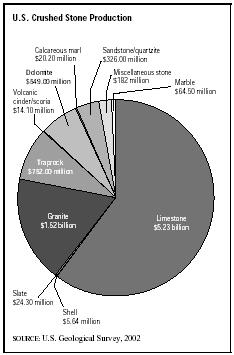SIC 1429
CRUSHED AND BROKEN STONE, NOT ELSEWHERE CLASSIFIED
This classification covers establishments primarily engaged in mining or quarrying crushed and broken stone, not elsewhere classified. Types of stone processed by this industry include basalt, diabase, dolomitic marble, gabbro, marble, mica schist, onyx marble, quartzite, sandstone, and volcanic rock.
NAICS Code(s)
212319 (Other Crushed and Broken Stone Mining and Quarrying)
In 2003, about 71 percent of the crushed stone produced in the United States was limestone and dolomite (see SIC 1422: Crushed and Broken Limestone ), followed by granite at 15 percent (see SIC 1423: Crushed and Broken Granite ), traprock at 7 percent, as well as sandstone, quartzite, shell, marble, calcareous marl, volcanic cinder and scoria, and slate, which combined to account for the remaining 7 percent of stone production. Only the latter 14 percent of crushed stone production is included in this industry.
After output declined in both 2002 and 2003, the crushed stone industry was expected to enjoy modest growth in 2004, fueled in part by increased federal spending on highway construction and maintenance. For example, the Safe, Accountable, Flexible, and Efficient Transportation Equity Act of 2003 is expected to boost demand for crushed stone.
The mining of aggregate was relatively unorganized and undocumented in the nineteenth century. It was not until 1882, when the U.S. Geological Survey began compiling an annual Mineral Resources of the United States publication, that the classification, method, and organization of the aggregate industry began to take shape. The Mineral Resources of the United States added its first chapter on stone in 1889. Aggregate production was originally reported in dollar amounts of product sold but has since been assessed in terms of both tons and dollar value of product sold or used. Production volume of crushed stone has escalated dramatically throughout the twentieth century. The dollar value of crushed stone in 1900 was $24 million. In 1950, this increased to $422 million, representing 325 million tons of crushed stone. The crushed stone industry in 2003 was valued at more than $8 billion, representing nearly 1.5 billion metric tons produced.
The crushed stone industry has been labor intensive since its inception in the late 1800s. Early production advancements came in the first decade of the twentieth century when company-owned steam locomotives and quarry cars replaced steam tractors and mule-powered carts in quarry operations. Characterized by innovation and inventiveness, the stone crushing industry also improved the quantity and quality of production when it began incorporating sophisticated processing equipment and quarry machines in the 1940s. Product quality and quality control have increased steadily throughout the twentieth century as technology has continued to keep pace with the production demands of the stone crushing industry. The largest association concerned with the health of this and other nonmetallic mineral mining and quarrying industries is the National Stone Association, which was founded in Columbus, Ohio in 1918 by a group of concerned quarry operators.
Valued at $752 million, production of traprock totaled 112 million metric tons in 2002, reflecting a 9.2 decline from 2001. A total of 222 businesses produced traprock in 2002, and the majority of them were located in Oregon, Virginia, Washington, New Jersey, and California.

In fact, these five states accounted for roughly 55 percent of U.S. traprock production.
Sandstone and quartzite operations are centered in Pennsylvania, Arkansas, California, South Dakota, and Oklahoma. In 2002 sandstone production grew 2.6 percent to 39.7 million metric tons, valued at $249.7 million, while quartzite production declined 7 percent to 13.2 million metric tons, valued at $76.8 million. Crushed quartzite and sandstone companies numbered 35 and 110, respectively.
The industry is comprised of many small companies and a few large corporations. In 2002, a total of 405 trap rock quarries operated in the United States, as did 185 sandstone and quartzite quarries, 13 slate quarries, and 41 volcanic cinder and scoria quarries. Vulcan Materials Co. of Birmingham, Alabama was the leading crushed stone producer by output in 2003, with 220 active crushed stone operations and $2.6 billion in total sales (including nonstone sales). Other leaders included Martin Marietta Materials Inc., and Trap Rock Industries Inc.
Further Reading
Barksdale, Richard D., ed. The Aggregate Handbook. Washington DC: National Stone Association.
U.S. Geological Survey. Mineral Commodity Summaries, January 2004. Available from http://minerals.usgs.gov/minerals/pubs/mcs/2004/mcs2004.pdf .
U.S. Geological Survey. Minerals Yearbook. Washington, DC:2002.
Comment about this article, ask questions, or add new information about this topic: